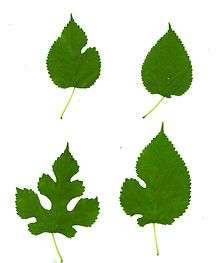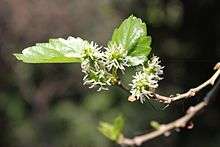Morus alba
Morus alba, known as white mulberry, is a fast-growing, small to medium-sized mulberry tree which grows to 10–20 m (33–66 ft) tall. It is generally a short-lived tree with a lifespan comparable to that of humans, although there are some specimens known to be over 250 years old.[2] The species is native to northern China and India[3], and is widely cultivated and naturalized elsewhere (United States, Mexico, Australia, Kyrgyzstan, Argentina, Turkey, Iran, etc.).[4][5][6][7][8][9]
| Morus alba | |
|---|---|
| Scientific classification | |
| Kingdom: | Plantae |
| Clade: | Tracheophytes |
| Clade: | Angiosperms |
| Clade: | Eudicots |
| Clade: | Rosids |
| Order: | Rosales |
| Family: | Moraceae |
| Genus: | Morus |
| Species: | M. alba |
| Binomial name | |
| Morus alba L. 1753 | |
| Subspecies | |
| |
| Synonyms[1] | |
| |
The white mulberry is widely cultivated to feed the silkworms employed in the commercial production of silk. It is also notable for the rapid release of its pollen, which is launched at over half the speed of sound.[10] Its berries are edible when ripe.
Description
On young, vigorous shoots, the leaves may be up to 30 cm (12 in) long, and deeply and intricately lobed, with the lobes rounded. On older trees, the leaves are generally 5–15 cm (2.0–5.9 in) long, unlobed, cordate at the base and rounded to acuminate at the tip, and serrated on the margins. The trees are generally deciduous in temperate regions, but trees grown in tropical regions can be evergreen. The flowers are single-sex catkins; male catkins are 2–3.5 cm (0.8–1.4 in) long, and female catkins 1–2 cm (0.4–0.8 in) long. Male and female flowers are usually on separate trees although they may occur on the same tree.[11][12] The fruit is 1–1.5 cm (0.4–0.6 in) long; in the species in the wild it is deep purple, but in many cultivated plants it varies from white to pink; it is sweet but bland, unlike the more intense flavor of the red mulberry and black mulberry. The seeds are widely dispersed in the droppings of birds that eat the fruit.[4][5][13]
The white mulberry is scientifically notable for the rapid plant movement involved in pollen release from its catkins. The stamens act as catapults, releasing stored elastic energy in just 25 µs. The resulting movement is approximately 380 miles per hour (610 km/h), about half the speed of sound, making it the fastest known movement in the plant kingdom.[10]
Taxonomy
Two varieties of Morus alba are recognized:[4]
- Morus alba var. alba
- Morus alba var. multicaulis
Cultivation


Cultivation of white mulberry for silkworms began over four thousand years ago in China. In 2002, 6,260 km2 of land were devoted to the species in China.[5]
The species is now extensively planted and widely naturalized throughout the warm temperate world. It has been grown widely from the Indian subcontinent[5] west through Afghanistan and Iran to southern Europe for over a thousand years for leaves to feed silkworms.[13]
More recently, it has become widely naturalized in disturbed areas such as roadsides and the edges of tree lots, along with urban areas in much of North America, where it hybridizes readily with the locally native red mulberry (Morus rubra). There is now serious concern for the long-term genetic viability of the red mulberry because of extensive hybridization in some areas.[14]
Uses
.jpg)

White mulberry leaves are the preferred feedstock for silkworms, and are also cut for food for livestock (cattle, goats, etc.) in areas where dry seasons restrict the availability of ground vegetation. The leaves are prepared as tea in Korea. The fruit are also eaten, often dried or made into wine.[5][13]
For landscaping, a fruitless mulberry was developed from a clone for use in the production of silk in the U.S. The industry never materialized, but the mulberry variety is now used as an ornamental tree where shade is desired without the fruit.[15] A weeping cultivar of white mulberry, Morus alba 'Pendula', is a popular ornamental plant.[16] The species has become a popular lawn tree across the desert cities of the southwestern United States, prized for its shade and also for its cylindrical berry clusters composed of sweet, purplish-white fruits.[17] The plant's pollen has become problematical in some cities where it has been blamed for an increase in hay fever.[18][19][20]
Medicinal
Various extracts from Morus alba including kuwanon G, moracin M, steppogenin-4′-O-β-D-glucoside and mulberroside A have been suggested as having a variety of potentially-useful medical effects.[21][22][23][24][25][26][27][28][29][30][31]}} Cyanidin-3-O-beta-ᴅ-glucopyranoside and Sanggenon G extracted from Morus alba were studied in animals models for some effects on the central nervous system, but clinical trials are necessary to confirm the effects. [32]
Gallery
 Leaves and fruit
Leaves and fruit Fruitless mulberry trees
Fruitless mulberry trees Pennsylvania state champion Morus alba at Longwood Gardens.
Pennsylvania state champion Morus alba at Longwood Gardens. Leaves and male flowers in the spring.
Leaves and male flowers in the spring.
References
- "Morus alba L.". World Checklist of Selected Plant Families (WCSP). Royal Botanic Gardens, Kew – via The Plant List.
- "The thickest, tallest, and oldest white mulberry trees (Morus alba)".
- http://old.worldagroforestry.org/treedb2/AFTPDFS/Morus_alba.PDF
- Wu, Zhengyi; Zhou, Zhe-Kun; Gilbert, Michael G. "Morus alba". Flora of China. 5. Retrieved 27 June 2013 – via eFloras.org, Missouri Botanical Garden, St. Louis, MO & Harvard University Herbaria, Cambridge, MA.
- Suttie, J. M. (undated). FAO Report: Morus alba L.
- Wunderlin, Richard P. (1997). "Morus alba". In Flora of North America Editorial Committee (ed.). Flora of North America North of Mexico (FNA). 3. New York and Oxford – via eFloras.org, Missouri Botanical Garden, St. Louis, MO & Harvard University Herbaria, Cambridge, MA.
- "Morus alba". County-level distribution map from the North American Plant Atlas (NAPA). Biota of North America Program (BONAP). 2014.
- Atlas of Living Australia, Morus alba L., White Mulberry
- SEINet, Southwestern Biodiversity, Arizona chapter photos, description, distribution map
- Taylor, Philip; Gwyneth Card; James House; Michael Dickinson; Richard Flagan (2006-03-01). "High-speed pollen release in the white mulberry tree, Morus alba L". Sexual Plant Reproduction. 19 (1): 19–24. doi:10.1007/s00497-005-0018-9.
- Schaffner, John H. 1919. The nature of the diecious condition in Morus alba and Salix amygdaloides. Ohio Journal of Science 18: 101-125.
- Purdue University. Center for New Crops & Plant Products. NewCROP: Morus alba.
- Bean, W. J. (1978). Trees and Shrubs Hardy in the British Isles. John Murray ISBN 0-7195-2256-0.
- Burgess, K.S., Morgan, M., Deverno, L., & Husband, B. C. (2005). Asymmetrical introgression between two Morus species (M. alba, M. rubra) that differ in abundance. Molec. Ecol. 14: 3471–3483.
- Howstuffworks.com
- "Morus alba". Natural Resources Conservation Service PLANTS Database. USDA.
- Little, Elbert L. (1994) [1980]. The Audubon Society Field Guide to North American Trees: Western Region (Chanticleer Press ed.). Knopf. p. 424. ISBN 0394507614.
- Pollen Library, White Mulberry (Morus alba)
- Thermo Scientific,
- University of Arizona Cooperative Extension, Yavapai County, Plants That May Cause Allergies in Yavapai County Archived 2016-06-16 at the Wayback Machine
- "Kuwanon G: an antibacterial agent from the root bark of Morus alba against oral pathogens"
- Hypolipidemic and antioxidant effects of mulberry (Morus alba L.) fruit in hyperlipidaemia rats Yang X., Yang L., Zheng H. Food and Chemical Toxicology 2010 48:8-9 (2374-2379)
- Mulberry fruit protects dopaminergic neurons in toxin-induced Parkinson's disease models. Kim H.G., Ju M.S., Shim J.S., Kim M.C., Lee S.H., Huh Y., Kim S.Y., Oh M.S. The British Journal of Nutrition 2010 104:1 (8-16)
- Albanol a from the root bark of Morus alba L. induces apoptotic cell death in HL60 human leukemia cell line Kikuchi T., Nihei M., Nagai H., Fukushi H., Tabata K., Suzuki T., Akihisa T. Chemical and Pharmaceutical Bulletin 2010 58:4 (568-571)
- In vivo hypoglycemic effects of phenolics from the root bark of Morus alba Zhang M., Chen M., Zhang H.-Q., Sun S., Xia B., Wu F.-H. Fitoterapia 2009 80:8 (475-477)
- Mulberroside A Possesses Potent Uricosuric and Nephroprotective Effects in Hyperuricemic Mice Wang C.-P., Wang Y., Wang X., Zhang X., Ye J.-F., Hu L.-S., Kong L.-D. [Article in Press] Planta Medica 2010
- Kim, JK; Kim, M; Cho, SG; Kim, MK; Kim, SW; Lim, YH (2010). "Biotransformation of mulberroside a from Morus alba results in enhancement of tyrosinase inhibition". Journal of Industrial Microbiology & Biotechnology. 37 (6): 631–7. doi:10.1007/s10295-010-0722-9. PMID 20411402.
- Adaptogenic effect of Morus alba on chronic footshock-induced stress in rats Nade V.S., Kawale L.A., Naik R.A., Yadav A.V. Indian Journal of Pharmacology 2009 41:6
- Mulberry leaf extract restores arterial pressure in streptozotocin-induced chronic diabetic rats Naowaboot J., Pannangpetch P., Kukongviriyapan V., Kukongviriyapan U., Nakmareong S., Itharat A. Nutrition Research 2009 29:8 (602-608)
- Antihyperglycemic, antioxidant and antiglycation activities of mulberry leaf extract in streptozotocin-induced chronic diabetic rats Naowaboot J., Pannangpetch P., Kukongviriyapan V., Kongyingyoes B., Kukongviriyapan U. Plant Foods for Human Nutrition 2009 64:2 (116-121)
- Neutralization of local and systemic toxicity of Daboia russelii venom by Morus alba plant leaf extract Chandrashekara K.T., Nagaraju S., Usha Nandini S., Basavaiah , Kemparaju K. Phytotherapy Research 2009 23:8 (1082-1087)
- Tam, Dao Ngoc Hien; Nam, Nguyen Hai; Elhady, Mohamed Tamer; Tran, Linh; Hassan, Osama Gamal; Sadik, Mohamed; Tien, Phan Thi My; Elshafei, Ghada Amr; Huy, Nguyen Tien (2020-05-07). "Effects of Mulberry on the Central Nervous System: A Literature Review". Current Neuropharmacology. 18. doi:10.2174/1570159X18666200507081531.
External links
![]()
- USDA Plants Profile for Morus alba white mulberry}
- "Morus alba". Germplasm Resources Information Network (GRIN). Agricultural Research Service (ARS), United States Department of Agriculture (USDA).
- Morton Arboretum: Diagnostic photos of white mulberry tree (acc. 380*82-1)
- Invasive.org: U.S. National Forest Service, Invasive Species Weed of the Week − Morus alba
| Wikimedia Commons has media related to Morus alba. |